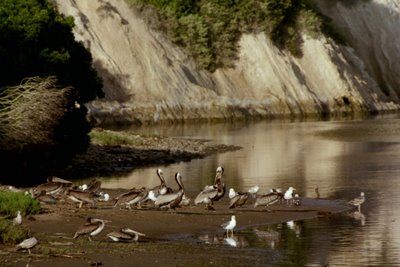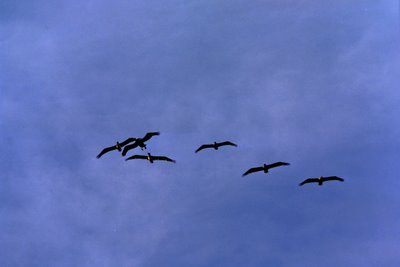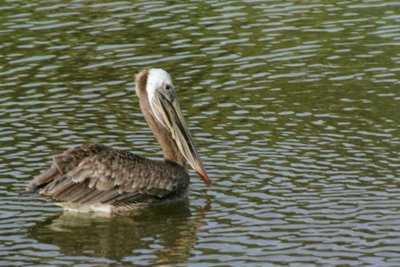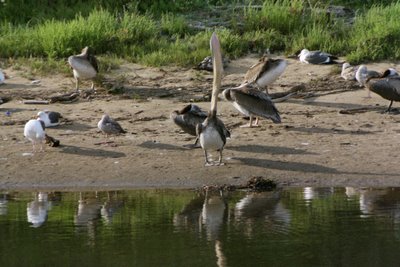 One of the things I enjoy most about living here is the birding. We go from the beach to 4,000 ft in the mountains in the space of five miles or less. We pack in a lot of habitat types in a small space which results in a large number of species.
One of the things I enjoy most about living here is the birding. We go from the beach to 4,000 ft in the mountains in the space of five miles or less. We pack in a lot of habitat types in a small space which results in a large number of species.This is my first opportunity to live on a coast and one of the birds I have come to know better and appreciate is the Brown Pelican (Pelecanus occidentalis). They are fairly plentiful here and have bounced back well from their population nadir after the DDT ban was enforced. Their populations are increasing - in fact there was a news report this week that said a group of nesters had recolonized Prince Island, an islet just off San Miguel Island. It was the first time Brown Pelicans had nested there since the late 1930s.
I love the way they glide in formation. With their heads tucked back and their bills dropped they look like pterodactyls.
 They have such an ungainly awkward grace about the way they move. I also really enjoy watching them dive. When they spot a fish from the air, they "fold-up" and drop like a rock to hit the fish.
They have such an ungainly awkward grace about the way they move. I also really enjoy watching them dive. When they spot a fish from the air, they "fold-up" and drop like a rock to hit the fish. This one did it right in front of me just before I took his picture. A big splash. They are such big birds, often 50 inches long with a nearly eight foot wingspan.
This one did it right in front of me just before I took his picture. A big splash. They are such big birds, often 50 inches long with a nearly eight foot wingspan.They also have these strange things they do with their bills and pouches. I caught one in this picture.
 In his "Lives of North American Birds" Kenn Kaufmann speculates that these are stretching exercises to keep the pouch pliable. Whatever it's for, it sure looks strange.
In his "Lives of North American Birds" Kenn Kaufmann speculates that these are stretching exercises to keep the pouch pliable. Whatever it's for, it sure looks strange.I took these pictures last week at the confluence of Atascadero Creek and Goleta Slough, which is about 300 yards from where the Slough runs into the ocean. It was about an hour before sunset and the tide was rising. With the beach, tidewater creeks, and nearby brackish marshes, it is a happening place for all sorts of birds besides the pelicans.
I know I should be moving to and embracing digital photography, but my old "analog" stuff still takes good pictures. I took these with my old Canon FTb using a 100-500mm zoom.
2 comments:
I won't deny that pelicans look something like pterodactyls, but you might be interested to know that (so far as we can tell from the way their neck vertebrae articulate), pterosaurs were actually incapable of folding their necks up as pelicans (and herons) can.
I'm inspired to now write lots (for my blog) about similarities and differences between pelicans and pterosaurs. Alas, too busy with stuff on domestic dogs (stay tuned for that).
I look forward to reading about pterosaurs and pelicans! I also look forward to reading about dogs. I don't know what aspects of dogs you are working on, but Steve and I are both very interested in the timing and location of the original domestication of dogs, the role that dogs may have played as a necessary "technology" for use in the peopling of the New World, and how our species have evolved together over the last 15,000 years or so.
Haven't had a chance to tell you how much I enjoy and admire your blog and congratulations on your PhD.
Post a Comment